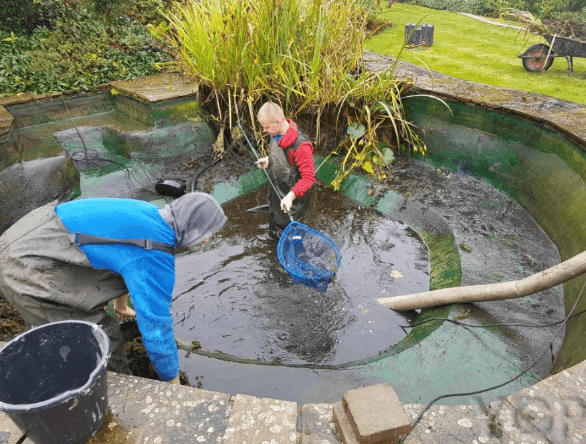Cleaner Pond Solutions for Healthy and Beautiful Water Features

A cleaner pond is more than just an attractive feature in your backyard; it is a sign of a healthy aquatic environment. Clear water allows you to enjoy the beauty of fish, plants, and natural reflections. It also creates a balanced ecosystem where algae, bacteria, and aquatic life coexist without overwhelming each other. Neglecting pond cleanliness can lead to murky water, unpleasant odors, and unhealthy conditions for fish. Maintaining water clarity benefits both the aesthetic value and long-term sustainability of your pond.
Understanding the Causes of Dirty Pond Water
Before working toward a cleaner pond, it’s essential to understand the root causes of cloudy or discolored water. Identifying these issues early allows pond owners to take targeted steps toward prevention rather than constantly battling symptoms. Several factors can contribute to pond pollution and poor water clarity.
Organic Debris – Fallen leaves, grass clippings, twigs, and uneaten fish food eventually sink to the bottom, where they decompose. As this organic matter breaks down, it releases ammonia and other harmful substances into the water, feeding algae and lowering overall water quality. Without regular removal or an efficient pond filter system, this buildup can lead to foul odors, murky water, and harmful gas production in the pond’s lower layers.
Algae Growth – When a pond receives excessive nutrients—often from decaying matter or runoff—and plenty of sunlight, algae can multiply rapidly. These blooms not only turn the water green but also consume oxygen at night, stressing fish and other aquatic life. Certain types, like string algae, can clog pumps and filters, making maintenance even more challenging.
Fish Waste – While fish bring life and beauty to a pond, their waste produces ammonia, which can be toxic in high concentrations. In ponds with too many fish or inadequate filtration, this waste quickly accumulates, overwhelming the natural biological processes meant to keep water safe. Over time, this can create a cycle of poor water quality that’s hard to break.
Runoff Pollution – Heavy rain can wash soil, fertilizers, pesticides, and other chemicals from surrounding areas directly into the pond. This sudden influx of nutrients disrupts the ecological balance, encourages excessive algae growth, and may introduce harmful toxins to fish and plants. Proper landscaping, buffer zones, and pond edging can help reduce the effects of runoff.
By understanding these underlying causes, pond owners can choose the right combination of maintenance practices, pond filter systems, and preventive measures to keep water clean, clear, and healthy all year long.
Key Steps to Achieve a Cleaner Pond
Achieving lasting clarity requires a combination of mechanical cleaning, proper filtration, and environmental adjustments.
Use Effective Filtration
A reliable filter removes both solid waste and harmful compounds. Mechanical filtration traps debris, while biological filtration supports beneficial bacteria that break down toxins. For extra clarity, consider a UV clarifier to control microscopic algae.
Remove Debris Regularly
Skim leaves and floating debris before they sink to the bottom. A pond net or skimmer is a quick way to keep the surface clear. For larger ponds, a surface skimmer connected to the pump can automate debris collection.
Control Algae Growth
Algae control starts with limiting excess nutrients. Reduce overfeeding, maintain plant coverage to shade the water, and avoid letting lawn fertilizers wash into the pond. Adding barley straw or liquid algae treatments can also help maintain a cleaner pond naturally.
The Role of Aquatic Plants
Plants play a big part in water quality. Floating plants like water lilies and water hyacinths provide shade, reducing sunlight penetration and slowing algae growth. Submerged plants release oxygen into the water and compete with algae for nutrients, making the environment more balanced. Marginal plants along the pond’s edge act as natural filters, absorbing nitrates and phosphates that feed algae.
Seasonal Maintenance for a Cleaner Pond
Keeping a cleaner pond all year requires adapting your care routine to the seasons.
Spring Preparation
- Inspect and clean the filter before peak activity begins.
- Remove any leftover leaves or sludge from winter.
- Replant aquatic plants for nutrient control.
Summer Upkeep
- Monitor water temperature and oxygen levels.
- Increase filtration if fish activity is high.
- Remove floating algae promptly.
Autumn Cleanup
- Use a pond net to catch falling leaves.
- Trim back dying plants to prevent decay.
- Reduce feeding as temperatures drop.
Winter Care
- Keep a small section of the pond surface ice-free for gas exchange.
- Remove the filter or switch to winter mode if required.
Advanced Tips for a Cleaner Pond
Beyond basic care, certain advanced strategies can help maintain consistent clarity.
- Install a Bottom Drain: This makes it easier to remove sludge from the pond floor.
- Add Beneficial Bacteria: Regular doses help break down organic waste.
- Improve Circulation: A fountain or waterfall oxygenates the water and prevents stagnation.
- Limit Fish Stocking: Overcrowding increases waste and filtration demand.
Eco-Friendly Ways to Maintain Pond Clarity
A cleaner pond can be achieved without harsh chemicals. Natural methods like adding oxygenating plants, encouraging beneficial microbes, and using barley straw extract reduce algae naturally. Rain gardens near the pond can filter runoff before it reaches the water, reducing nutrient overload.
Avoiding Common Mistakes in Pond Cleaning
Many pond owners unintentionally make problems worse by over-cleaning or using strong chemicals. Removing all algae disrupts the ecosystem and can lead to rapid regrowth. Overuse of chemical treatments may harm fish and beneficial bacteria. Instead, focus on balanced management, allowing some natural elements to remain while preventing excess buildup.
Long-Term Benefits of a Cleaner Pond
Maintaining a cleaner pond rewards you with:
- A visually stunning water feature that enhances your landscape.
- Healthier fish and plants thanks to stable water conditions.
- Lower maintenance costs by preventing major water quality problems.
- A more balanced ecosystem that requires fewer interventions over time.
Final Thoughts
A cleaner pond is the result of consistent care, smart filtration, and understanding the needs of your aquatic ecosystem. By removing debris, controlling nutrients, and making seasonal adjustments, you can enjoy a pond that remains beautiful and healthy all year. Whether you prefer natural methods or a mix of technology and hands-on work, maintaining water clarity ensures your pond remains a relaxing, attractive centerpiece in your outdoor space.
Clearing Up Confusion
How often should I clean my pond filter?
Most pond filters need a light cleaning every two to four weeks during peak seasons. However, avoid over-cleaning biological media to protect beneficial bacteria that keep the water balanced.
What’s the easiest way to remove algae from a pond?
A combination of shading the water with plants, reducing excess nutrients, and using a UV clarifier is the most effective long-term approach. Manual removal works, but prevention is more sustainable.
Can I keep my pond clear without chemicals?
Yes. Natural methods like adding oxygenating plants, installing proper filtration, and maintaining good circulation can keep the water clear without relying on chemical treatments.
Why does my pond water turn green so quickly?
Green water is usually caused by free-floating algae that thrive in warm, nutrient-rich conditions. High sunlight exposure and overfeeding fish can accelerate the problem.
Is a pond vacuum worth buying?
For large or heavily stocked ponds, a pond vacuum is an excellent tool for removing sludge and debris from the bottom, helping maintain water clarity with less manual effort.





